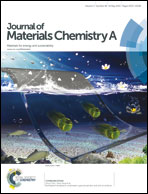Palladium copper nanosponges for electrocatalytic reduction of oxygen and glucose detection†
Abstract
A facile and one-pot wet chemical approach has been applied for the preparation of palladium copper (PdCu) nanosponges (NSs) through the reduction of Pd2+ and Cu2+ ions with L-ascorbic acid in the presence of sodium dodecyl sulfate (SDS) at 95 °C. The PdCu NSs prepared in the presence of 12.5, 25, and 37.5 mM SDS have sizes of 46.0 ± 4.3, 36.8 ± 4.5, and 37.2 ± 2.6 nm, respectively. Relative to a Pd NP electrode (0.33 mA cm−2), Cu NP electrode (0.31 mA cm−2), commercial Pd/C electrode (0.34 mA cm−2) and Pt/C electrode (0.66 mA cm−2), PdCu NS-modified electrodes provide a high current density for the oxygen reduction reaction (1.93 mA cm−2) under alkaline conditions. In addition, the PdCu NS-modified electrodes provide high catalytic activity for glucose oxidation at −0.01 V vs. Ag/AgCl and are stable even after sweeping for 43 200 s in 0.1 M NaOH containing 0.1 M glucose. The higher catalytic activity of the PdCu NSs is mainly due to their greater electroactive surface area (EASA) and the synergistic effect caused by the intimate contact between Pd and Cu. The PdCu NS-modified electrodes exhibit high sensitivity (1560 μA mM−1 cm−2), good selectivity, and fast response to glucose over a linear range of 0–30 μM (R2 = 0.997), with a limit of detection (LOD) of 4.1 μM. With the advantages of good stability, excellent electrocatalytic activity, and cost effectiveness, PdCu NSs hold great potential for use in fuel cells using methanol or ethanol as fuel and for the fabrication of electrochemical sensors for the detection of glucose in blood samples.


 Please wait while we load your content...
Please wait while we load your content...